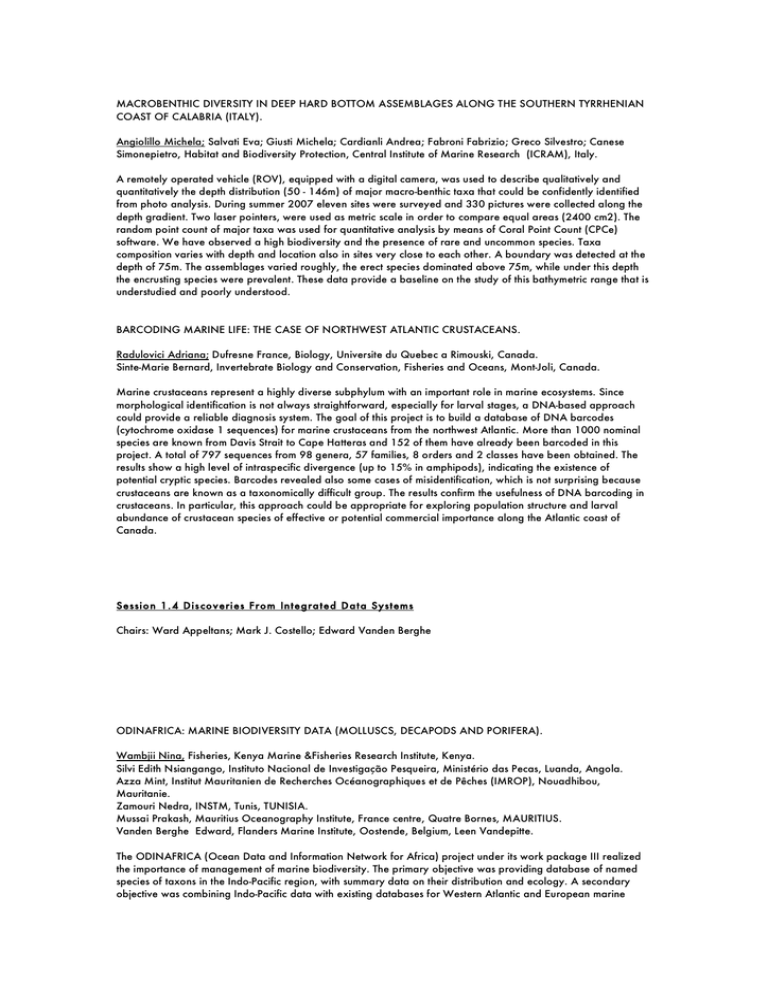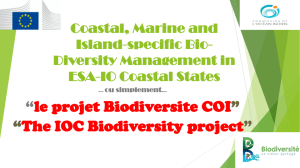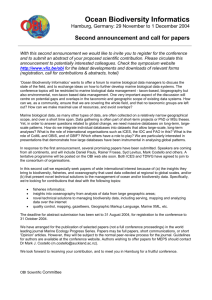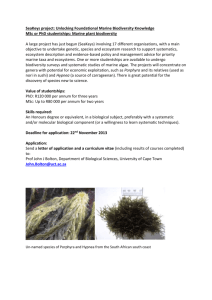MACROBENTHIC DIVERSITY IN DEEP HARD BOTTOM ASSEMBLAGES ALONG THE SOUTHERN... COAST OF CALABRIA (ITALY).
advertisement

MACROBENTHIC DIVERSITY IN DEEP HARD BOTTOM ASSEMBLAGES ALONG THE SOUTHERN TYRRHENIAN COAST OF CALABRIA (ITALY). Angiolillo Michela; Salvati Eva; Giusti Michela; Cardianli Andrea; Fabroni Fabrizio; Greco Silvestro; Canese Simonepietro, Habitat and Biodiversity Protection, Central Institute of Marine Research (ICRAM), Italy. A remotely operated vehicle (ROV), equipped with a digital camera, was used to describe qualitatively and quantitatively the depth distribution (50 - 146m) of major macro-benthic taxa that could be confidently identified from photo analysis. During summer 2007 eleven sites were surveyed and 330 pictures were collected along the depth gradient. Two laser pointers, were used as metric scale in order to compare equal areas (2400 cm2). The random point count of major taxa was used for quantitative analysis by means of Coral Point Count (CPCe) software. We have observed a high biodiversity and the presence of rare and uncommon species. Taxa composition varies with depth and location also in sites very close to each other. A boundary was detected at the depth of 75m. The assemblages varied roughly, the erect species dominated above 75m, while under this depth the encrusting species were prevalent. These data provide a baseline on the study of this bathymetric range that is understudied and poorly understood. BARCODING MARINE LIFE: THE CASE OF NORTHWEST ATLANTIC CRUSTACEANS. Radulovici Adriana; Dufresne France, Biology, Universite du Quebec a Rimouski, Canada. Sinte-Marie Bernard, Invertebrate Biology and Conservation, Fisheries and Oceans, Mont-Joli, Canada. Marine crustaceans represent a highly diverse subphylum with an important role in marine ecosystems. Since morphological identification is not always straightforward, especially for larval stages, a DNA-based approach could provide a reliable diagnosis system. The goal of this project is to build a database of DNA barcodes (cytochrome oxidase 1 sequences) for marine crustaceans from the northwest Atlantic. More than 1000 nominal species are known from Davis Strait to Cape Hatteras and 152 of them have already been barcoded in this project. A total of 797 sequences from 98 genera, 57 families, 8 orders and 2 classes have been obtained. The results show a high level of intraspecific divergence (up to 15% in amphipods), indicating the existence of potential cryptic species. Barcodes revealed also some cases of misidentification, which is not surprising because crustaceans are known as a taxonomically difficult group. The results confirm the usefulness of DNA barcoding in crustaceans. In particular, this approach could be appropriate for exploring population structure and larval abundance of crustacean species of effective or potential commercial importance along the Atlantic coast of Canada. Session 1. 4 Dis cov eries From Integrated Data Systems Chairs: Ward Appeltans; Mark J. Costello; Edward Vanden Berghe ODINAFRICA: MARINE BIODIVERSITY DATA (MOLLUSCS, DECAPODS AND PORIFERA). Wambjii Nina, Fisheries, Kenya Marine &Fisheries Research Institute, Kenya. Silvi Edith Nsiangango, Instituto Nacional de Investigação Pesqueira, Ministério das Pecas, Luanda, Angola. Azza Mint, Institut Mauritanien de Recherches Océanographiques et de Pêches (IMROP), Nouadhibou, Mauritanie. Zamouri Nedra, INSTM, Tunis, TUNISIA. Mussai Prakash, Mauritius Oceanography Institute, France centre, Quatre Bornes, MAURITIUS. Vanden Berghe Edward, Flanders Marine Institute, Oostende, Belgium, Leen Vandepitte. The ODINAFRICA (Ocean Data and Information Network for Africa) project under its work package III realized the importance of management of marine biodiversity. The primary objective was providing database of named species of taxons in the Indo-Pacific region, with summary data on their distribution and ecology. A secondary objective was combining Indo-Pacific data with existing databases for Western Atlantic and European marine species form a global database. Already 6,460 records on Mollusca were entered into the aphia-database with a “Masdea”- context, representing 4,772 species. Gastropoda had (3,505 species) and 1,105 species of Bivalvia. Only 224 records are considered invalid taxon names. For 3,955 species, the authority is known. Presently, 3 877 taxa from Order Decapoda have 2,948 species and subspecies worldwide. 2 752 species and subspecies names are valid. Seychelles had (649), Mauritania (468) and South Africa (458). North Africa and East Africa are heavily undersampled and West Africa is reasonably sampled. Presently, 1 883 taxa from Phylum Porifera have 1 309 known species and subspecies worldwide. Class Demospongiae had 1 255 species, Calcarea -37 and Hexactinellida (17). 570 species were considered to be invalid or synonyms. 1307 taxa were recorded from East Africa region, 538 West Africa and 318 from South Africa. This database is part of the Ocean Biogeographic Information System (OBIS). Session 1. 5 Ope n O cean Pelagic And Benthopelagi c Div ersity: Patterns A nd Monitoring Chairs: Odd Aksel Bergstad; Ann Bucklin; Tone Falkenhaug; Uwe Piatkowski. THE COMPLETE MITOCHONDRIAL GENOME SEQUENCE OF THE PLANKTONIC CHAETOGNATH SAGITTA NAGAE Hiroomi Miyamoto; Shuhei Nishida, Tokyo University, Ocean Research Institute, Japan. Chaetoganths, commonly called arrow worms, are small marine animals and constitute a single phylum of about 120 species. Recently two complete mitochondrial genome (mtDNA) sequences of two benthic chaetognaths (Paraspadella gotoi and Spadella cephaloptera) were determained, and they were highly different from those of general metazoans. However, complete mtDNA sequences of planktonic species that comprise most of this group have not been examined. In this study, We determined the complete mtDNA sequence of a planktonic species, Sagitta nagae. The S. nagae mtDNA (11,468 bp) is one of the smallest circular genome. It encodes 14 genes (11 protein coding genes, 1 tRNA gene, and 2 rRNA genes), and loses 23 genes that are usually present in metazoan mtDNA. This gene set encoded in S. nagae mtDNA is the same as in the two benthic chaetognaths. In addition, there were considerable gene rearrangements between S. nagae and the two benthic species among a set of 7 genes, while no such rearrangement were observed in the other 7 genes. This is also the case between the benthic species, hence appears to be a common feature in the chaetognath. BIODIVERSITY OF MESOZOOPLANKTON IN THE SULU SEA AND ITS ADJACENT WATERS WITH SPECIAL REFERENCE TO COPEPODS. Nishikawa Jun; Nishida Shuhei, Ocean Research Institute, The University of Tokyo, Japan. The Sulu Sea (SS) is a semi-enclosed basin located in the western equatorial Pacific, exhibiting a homogeneous and unusually warm (ca. 10 ‹C) water from the mesopelagic zone to the sea bottom. The relationships between vertical water-column structure and biomass, biodiversity and patterns of vertical distribution of mesozooplankton were examined and compared with those in the adjacent Celebes and South China Seas which show more enormal f oceanic conditions. While the warm and homogeneous mesopelagic water in the SS does not drastically influence total standing stocks, vertical distribution patterns and the community structure at the higher taxonomic levels of mesozooplankton, the marked difference was found in the order, family, genus and species composition of copepods. Species richness of copepods was much lower in the mesopelagic layer in the SS, but several possible new species have found, suggesting the effect of the homogeneous and warm water on biodiversity of copepods. PELAGIC SPECIES DIVERSITY IN THE CENTRAL-SOUTHERN MEDITERRANEAN – OVERVIEW FROM LONGTERM FIELD RESEARCH. Vella Adriana, Conservation Biology Research Group, Dept. of Biol. University of Malta, MALTA. A ten year (1997-2007) time frame from on-going long-term research on cetaceans, turtles, seabirds, manta rays in the central and southern Mediterranean is considered side by side to Bluefin and other fisheries data to look into the environmental and life history factors affecting distribution and abundance of all these diverse pelagic species. Species associations are investigated to understand if there are beneficial, disruptive or neutral effects. Human activities and impacts are also considered. Considerations of the future off shore developments in the region for fuel exploration and wind energy plants, over and above the ever increasing vessel traffic, fishing effort








